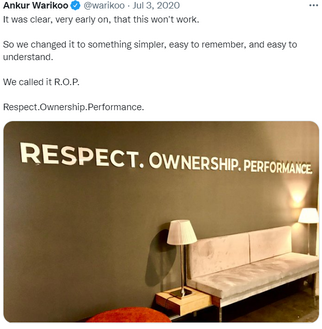Adhocracy Culture: Help Your Employees Become Innovative And Adaptable
Culture eats strategy for breakfast. That's a common (and true) phrase we all have heard. But there's a catch. Your culture won't hold up well over the next ten years unless it is flexible and prepared to adapt to any scenario. In today's world, culture only won't suffice, and you need an adhocracy culture.
In this blog, we dive deep into the ins and outs of adhocracy culture in the workplace. We discover its features, pros, cons, and some exciting real-life examples. Furthermore, you will get insights on how HR professionals can foster this flexible and innovative culture.
But before we jump into the details of Adhocracy Culture, let's explore the different types of organizational cultures. Understanding them will set the stage for how Adhocracy brings flexibility and innovation.
Organizational Excellence and a Positive Culture
The cornerstone of every successful organization is a great culture. Three things happen when you have a strong workplace culture-
-
Employees understand how top management expects them to respond to each scenario.
-
They believe that their goals are relevant and achievable.
-
And finally, employees know that their efforts to adhere to the organization's goals and values will be aptly rewarded.
A great work culture reflects your beliefs and aligns with your overall objective. It takes time and works to develop a winning corporate culture. Indeed, it's a big task, but your efforts will pay off in the future.
To figure out their priorities regarding job satisfaction, Glassdoor surveyed more than 5,000 adults in the US, the UK, France, and Germany. 56 percent of workers, according to the report, rated a positive company culture as more significant than salary.
Types Of Organizational Culture
If we talk about the different types of organizational cultures, there is no such definitive list.
Although Kim Cameron and Robert Quinn defined four of the most common types of workplace culture, which were referred to in the Competing Values Framework.
They are:
1. The Clan Culture
A clan culture is family-like workplace culture. It appreciates everyone's thoughts and opinions where employees feel a strong sense of tradition, loyalty and collaboration.
2. The Hierarchy Culture
A hierarchical culture is formal and structured. Leaders take pride in their efficient coordination and organization.
3. The Market Culture
The Market culture is extremely competitive, results-driven, and market-oriented. This culture strives to penetrate the market and capture the greatest possible share.
4. The Adhocracy Culture
The adhocracy culture is famous for its flexibility. Also, for employee empowerment and emphasis on individual initiative.
A company doesn't need to have only one type of culture. Any company's culture can uniquely blend these four cultural models.
Here's a comprehensive table outlining key differences between Adhocracy Culture and Clan, Hierarchy, and Market Cultures.
| Aspect | Adhocracy Culture | Clan Culture | Hierarchy Culture | Market Culture |
|---|---|---|---|---|
| Organizational Structure | Flexible and decentralized, project-focused | Family-like atmosphere with collaborative values | Clearly defined levels of authority and structure | Emphasis on competition, results, and goal achievement |
| Decision-Making | Decentralized, involving individuals or small teams | Collaborative decision-making, input from various levels | Centralized, typically top-down decision-making | Decision-making based on market conditions and competition |
| Innovation and Risk-Taking | Encourages innovation, experimentation, and risk-taking | Values stability and tradition, with some openness to innovation | Tends to be risk-averse, centralized decision-making | Values calculated risk-taking and innovation for competitiveness |
| Communication | Open and transparent communication channels | Informal and interpersonal communication, relationship-based | Formal communication channels and protocols | Emphasizes clear and strategic communication for competitive positioning |
| Employee Roles | Dynamic and project-based teams, fluid roles | Emphasis on team collaboration and shared responsibilities | Clearly defined roles within a structured hierarchy | Roles tied to achieving market goals, competition, and results |
But, in this blog, we're only going to stick to the adhocracy culture. We'll delve deep into the adhocracy culture's features, examples, benefits, and drawbacks. But first:
What Is The Adhocracy Culture?
The term "adhocracy" combines the Latin phrase "ad hoc" and the Greek suffix "cracy."
"Ad hoc," which means "for the purpose," and "cracy," means "to govern." In essence, Adhocracy is a system of flexible and informal organization, steering away from rigid bureaucracy.
In business context, Adhocracy Culture means decentralized leadership and letting individuals take the lead. It's about organic decision-making, not strict rules.
Warren Bennis coined the phrase in his 1968 book The Temporary Society. It gained cultural significance when Alvin Toffler included it in his 1970 book "Future Shock."
What Does The Adhocracy Culture Focus On?
Adhocracy Culture focuses on promoting adaptability, innovation, and a willingness to take risks. It creates an environment that encourages individuals to freely share their creative ideas.
This sets the tone for our next segment where we discuss the top 5 features of an Adhocracy Culture.
Adhocracy Vs. Bureaucracy
They say, that the term "bureaucracy" became derogatory when the concept of Adhocracy started emerging.
Author, speaker, and management educator, Dr. Mike Clayton says,
The two are polar opposites: radically different ways to coordinate an organization. The bureaucracy is a set of rules and systems that overlay everything. The other is a new recreation for every unique need.
The concept of bureaucracy goes back to the nineteenth century. And adhocracy is new. But not as new as you think.
Here is a video you wouldn't want to miss if you want to know more about adhocracy!
The Top 5 Features Of An Adhocracy Culture
Here are some characteristics of the adhocracy culture.
1. Decentralised leadership
Leadership is decentralized in an adhocracy organizational structure. Choices are made rapidly, and things change frequently depending on current demands. Hierarchy, planning, and formal procedures may be less important. The emphasis is on the present work.
2. Promotes organic decision-making
It supports the individual initiative, organic decision-making, ownership, and respect in the work environment.

( Ankur is the Entrepreneur, and Founder of nearbuy.com )
3. Focuses on one common goal
Managing organizations with an adhocracy culture entail being a team leader. It aims to motivate many people to work toward a common goal.
4. Encourages creativity and innovation
This method emphasizes continuous innovation and risk-taking, promoting a relaxed atmosphere. Employees now have greater control over when and how they work. Adhocracies frequently recruit freelancers regularly for specific projects.
Read our blog on: 8 Ways To Encourage Innovation In The Workplace
5. Believes in having growth mindsets
Its purpose is to cultivate an adaptable mindset capable of quickly shifting gears. Internal resources must be ready to adapt to the ever-changing business environment. Specialized teams are immediately developed to meet any issues that may occur.
Examples Of Adhocracy Culture
Adhocracies are more common in businesses that use high technology and face intense competition. We can see this in the private sector, mostly.
These businesses depend on decision-makers ability to forecast the market. And they know exactly which changes in market conditions are important.
Also, they also know what technologies and tactics can help them respond.
Amazon
Take, for example, Amazon, which promotes an adhocracy culture. It prioritizes innovation through decentralizing power and accepts that most experiments will fail. It has small, flexible teams that focus on a greater customer experience.
Wikipedia
Furthermore, Wikipedia, founded in 2001, has no hierarchy or bureaucracy. It is managed by the Wikimedia Foundation, which has only a few full-time paid employees. The site is open to everyone and is well-known for its dedication to providing free content. It's a working example of an adhocracy business.
Tesla
Tesla's history of innovation reflects its adhocracy culture. Tesla has pioneered various technologies, including electric vehicles, solar roofs, and self-driving vehicles. Tesla's adhocracy culture also contributes to the company's ability to attract top people.
Tesla employees are encouraged to create and experiment with new ideas. This liberation enables people to take chances and be inventive. As a result, Tesla has created some of the world's most cutting-edge technologies.
NASA
Historically, prominent organizations, such as NASA, have spent much time as adhocracies. The United States founded NASA to avoid failures and turf wars among military branches during the space race. They gave NASA autonomy to land men safely on the moon within a decade.
Advantages And Disadvantages Of Adhocracy Culture

Often, adhocracy is favored over the traditional corporate structure of bureaucracy and meritocracy. A look at the benefits of adhocracy Culture below can explain why.
1. Quick, correct actions
Decisions are taken rather fast in response to pressing needs. It enables leaders to act instinctively in situations where extensive research seems ineffective.
2. Flexible
Adhocracy cultures are associated with flexibility in organizations. These companies can easily adapt to varying situations.
3. Free for experimentation
In such cultures, employees are not limited to a particular role. Instead, they are free to experiment with and get diverse skills and expertise. It enables them to wear many hats and take on tasks based on priority.
When the rules of a formal organization do not bind employees, they feel more in control of their professional lives. Employees are notified of new opportunities and have the option to switch roles.
77% of adults would evaluate a company's culture before applying to an open position
Source: Glassdoor
4. No top-down structure
No hierarchy results in easy communication and socialization. People are more at ease sharing their thoughts and opinions, allowing them to explore their creativity.
5. Engages employees
In this fast-paced work environment, there is always an imminent chance of burnout. Yet, in the adhocracy company culture, employees are more satisfied with their jobs. They live a higher quality of work life. The bottom line is that it boosts employee engagement. And, it improves mental and physical health.
Like any other management culture, the adhocracy culture also has its drawbacks. Here are a few to consider:
1. Communication gap
Because adhocracy cultures are low on the hierarchy, they rely on effective communication. Poor communication can result in vital things being overlooked. Or employees taking advantage of the efforts of others.
2. Not suitable for all business
Processes and procedures are lacking in adhocracy culture. And some organizations might stop operating under such circumstances. Consider hospitals and industries where safety and analyzing medical processes are critical.
Also, the lack of guidelines for proper behavior and performance standards can be frustrating. It may cause anxiety in employees who want to know they are valued.
Adhocracy should not be viewed as a "one size fits all" approach to corporate management, but as one feature that might contribute to a company's success. Additionally, some believe there should not be such a clear distinction between bureaucracies and adhocracies. Rather, the ideal model might be a "Bureau-Adhocracy," a combination of the two.
4. A problem with non-hierarchical structures
Boards of directors and shareholders might demand a chain of command to ensure the success and profitability of the company they work for. Thus, they may not support an organization without a hierarchy.
5. Extreme dependency on technology
An adhocracy relies heavily on modern technology. This dependency can hamper an organization's ability to distribute information to employees. It is especially true if the firm allows employees to work from home. Or when you need your staff to travel.
7. Expensive
Maintaining a high level of flexibility is difficult without investing in resources. For example, it can hamper training and technology. Thus, adhocracy can be costly.
How Does Adhocracy Culture Stand Out As The Ultimate Competitive Edge?
It's all about being bold and trying new things to make the business stand out. Think of it as a superhero move for corporate sustainability with a strategy that's super effective (Linnenluecke/Griffiths 2010).
In dynamic industries, where market conditions can shift rapidly, adhocracy culture shines. It's like having a toolkit for success in a constantly changing landscape.
With flexible processes, pioneering initiatives, and an innovative working atmosphere, it positions businesses to stay ahead of the curve.
For startups as well, adhocracy culture is like a dream come true. With adhocracy, startups can pivot, try out unconventional strategies, and navigate the twists and turns of the market. It fosters a mindset that values agility and embraces the unknown. And that is exactly what startups need to survive and thrive.
How HR Can Help Build Adhocracy Culture In The Workplace?
1. Check with your employees.
You must ensure that your employees are comfortable with change as an ad-hoc leader. You must believe in your team members, their abilities, and their adaptability.
2. Keep questioning and answering.
You must frequently clear up their misunderstandings and respond to their inquiries. What do we need? What are our aims? How can we improve? How can we progress from good to excellent?
Frequent question and answer sessions help adhocracy cultures strengthen team dynamics.
According to researchers, asking questions can help our brains develop new neural patterns. The more patterns the brain creates, the more efficiently it works. This approach is quite beneficial, especially in a setting where tedious tasks need to be completed.
3. Form your smart team.
To have a successful adhocracy culture, you must first have a good team. Gather a group of people able to work smarter within the framework of adhocracy.
They must be willing to experiment, take risks and be resilient to restart if necessary. It can seem terrifying for some organizations. But embracing change is essential to staying ahead of the competition.
4. Focus on the overall growth of your employees.
Create a workplace that supports employee growth. It is critical if you want to attract and keep top employees. Employees are more inclined to stay with your organization if they can develop throughout their employment.
















